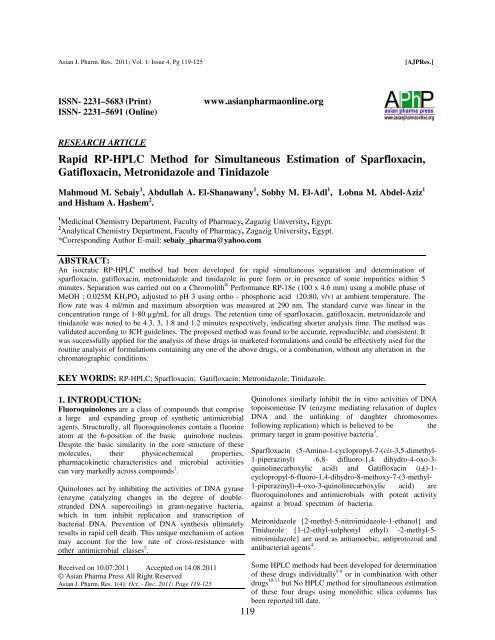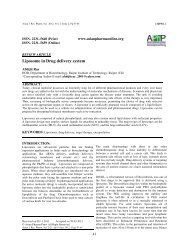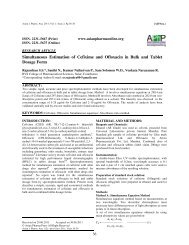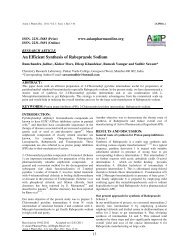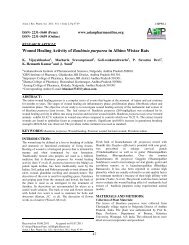Download PDF - asian pharma press
Download PDF - asian pharma press
Download PDF - asian pharma press
Create successful ePaper yourself
Turn your PDF publications into a flip-book with our unique Google optimized e-Paper software.
Asian J. Pharm. Res. 2011; Vol. 1: Issue 4, Pg 119-125<br />
[AJPRes.]<br />
ISSN- 2231–5683 (Print)<br />
www.<strong>asian</strong><strong>pharma</strong>online.org<br />
ISSN- 2231–5691 (Online) 0974-3618<br />
RESEARCH ARTICLE<br />
Rapid RP-HPLC Method for Simultaneous Estimation of Sparfloxacin,<br />
Gatifloxacin, Metronidazole and Tinidazole<br />
Mahmoud M. Sebaiy 1 , Abdullah A. El-Shanawany 1 , Sobhy M. El-Adl 1 , Lobna M. Abdel-Aziz 1<br />
and Hisham A. Hashem 2 .<br />
1 Medicinal Chemistry Department, Faculty of Pharmacy, Zagazig University, Egypt.<br />
2 Analytical Chemistry Department, Faculty of Pharmacy, Zagazig University, Egypt.<br />
*Corresponding Author E-mail: sebaiy_<strong>pharma</strong>@yahoo.com<br />
ABSTRACT:<br />
An isocratic RP-HPLC method had been developed for rapid simultaneous separation and determination of<br />
sparfloxacin, gatifloxacin, metronidazole and tinidazole in pure form or in presence of some impurities within 5<br />
minutes. Separation was carried out on a Chromolith ® Performance RP-18e (100 x 4.6 mm) using a mobile phase of<br />
MeOH : 0.025M KH 2 PO 4 adjusted to pH 3 using ortho - phosphoric acid (20:80, v/v) at ambient temperature. The<br />
flow rate was 4 ml/min and maximum absorption was measured at 290 nm. The standard curve was linear in the<br />
concentration range of 1-80 µg/mL for all drugs. The retention time of sparfloxacin, gatifloxacin, metronidazole and<br />
tinidazole was noted to be 4.3, 3, 1.8 and 1.2 minutes respectively, indicating shorter analysis time. The method was<br />
validated according to ICH guidelines. The proposed method was found to be accurate, reproducible, and consistent. It<br />
was successfully applied for the analysis of these drugs in marketed formulations and could be effectively used for the<br />
routine analysis of formulations containing any one of the above drugs, or a combination, without any alteration in the<br />
chromatographic conditions.<br />
KEY WORDS: RP-HPLC; Sparfloxacin; Gatifloxacin; Metronidazole; Tinidazole.<br />
1. INTRODUCTION:<br />
Fluoroquinolones are a class of compounds that comprise<br />
a large and expanding group of synthetic antimicrobial<br />
agents. Structurally, all fluoroquinolones contain a fluorine<br />
atom at the 6-position of the basic quinolone nucleus.<br />
Despite the basic similarity in the core structure of these<br />
molecules, their physicochemical properties,<br />
<strong>pharma</strong>cokinetic characteristics and microbial activities<br />
can vary markedly across compounds 1 .<br />
Quinolones act by inhibiting the activities of DNA gyrase<br />
(enzyme catalyzing changes in the degree of doublestranded<br />
DNA supercoiling) in gram-negative bacteria,<br />
which in turn inhibit replication and transcription of<br />
bacterial DNA. Prevention of DNA synthesis ultimately<br />
results in rapid cell death. This unique mechanism of action<br />
may account for the low rate of cross-resistance with<br />
other antimicrobial classes 2 .<br />
Received on 10.07.2011 Accepted on 14.08.2011<br />
© Asian Pharma Press All Right Reserved<br />
Asian J. Pharm. Res. 1(4): Oct. - Dec. 2011; Page 119-125<br />
119<br />
Quinolones similarly inhibit the in vitro activities of DNA<br />
topoisomerase IV (enzyme mediating relaxation of duplex<br />
DNA and the unlinking of daughter chromosomes<br />
following replication) which is believed to be the<br />
primary target in gram-positive bacteria 3 .<br />
Sparfloxacin (5-Amino-1-cyclopropyl-7-(cis-3,5-dimethyl-<br />
1-piperazinyl) -6,8- difluoro-1,4 dihydro-4-oxo-3-<br />
quinolinecarboxylic acid) and Gatifloxacin ((±)-1-<br />
cyclopropyl-6-fluoro-1,4-dihydro-8-methoxy-7-(3-methyl-<br />
1-piperazinyl)-4-oxo-3-quinolinecarboxylic acid) are<br />
fluoroquinolones and antimicrobials with potent activity<br />
against a broad spectrum of bacteria.<br />
Metronidazole {2-methyl-5-nitroimidazole-1-ethanol} and<br />
Tinidazole {1-(2-ethyl-sulphonyl ethyl) -2-methyl-5-<br />
nitroimidazole} are used as antiamoebic, antiprotozoal and<br />
antibacterial agents 4 .<br />
Some HPLC methods had been developed for determination<br />
of these drugs individually 5-9 or in combination with other<br />
drugs 10-13 but No HPLC method for simultaneous estimation<br />
of these four drugs using monolithic silica columns has<br />
been reported till date.
Asian J. Pharm. Res. 2011; Vol. 1: Issue 4, Pg 119-125<br />
In the present study, an attempt has been made to develop a<br />
method for the simultaneous estimation of sparfloxacin,<br />
gatifloxacin, metronidazole and tinidazole. It can also be<br />
applied for routine analysis of either one or of any<br />
combinations of these drugs in dosage forms.<br />
2. EXPERIMENTAL:<br />
2.1. Apparatus:<br />
• Waters 2487 ® HPLC instrument (U.S.A) with Waters<br />
automated gradient controller, Chromolith ® Performance<br />
RP-18e column (100 x 4.6 mm), dual absorbance detector,<br />
binary 515 HPLC pumps and connected to PC computer<br />
loaded with Millenium 32 software.<br />
• Consort P400 ® digital pH-meter for pH adjustment.<br />
2.2. Materials and reagents:<br />
• All solvents and reagents were of an HPLC analytical<br />
grade (methanol, potassium dihydrogen phosphate and<br />
ortho - phosphoric acid were supported from Romil,<br />
England).<br />
• Sparfloxacin (Global Napi), Gatifloxacin (EPCI),<br />
Metronidazole (Sanovi Aventis) and Tinidazole (Medical<br />
Union of Pharmaceuticals). Standard solutions 400 µg.ml -1<br />
were prepared individually by dissolving 40 mg of each<br />
pure drug in 100 ml of the mobile phase.<br />
• Mobile phase was a freshly prepared binary mixture of<br />
methanol: 0.025M potassium dihydrogen phosphate<br />
adjusted to pH 3 using ortho - phosphoric acid (20:80, v/v),<br />
filtered and degassed using 0.45µm membrane filter.<br />
• Manufacturing impurities like Benzyl amine,<br />
Ethylene diamine, 2,3,4-trifluoroaniline, 2,6-dimethyl<br />
piperazine, Diethyl malonate and 2-methyl imidazole were<br />
supported from Merck, Germany.<br />
2.3. Pharmaceutical preparations:<br />
The following available <strong>pharma</strong>ceutical preparations were<br />
analyzed<br />
• Spara ® tablets labeled to contain 200 mg sparfloxaacin<br />
per tablet. Batch No. 911601 (Global Napi, Egypt).<br />
• Gatiflox ® tablets labeled to contain 400 mg<br />
gatifloxacin per tablet. Batch No. 171080310 (EPCI,<br />
Egypt).<br />
• Flagyl ® tablets labeled to contain 500 mg<br />
metronidazole per tablet. Batch No. 10E70 (Sanovi<br />
Aventis, Egypt).<br />
• Protozole ® tablets labeled to contain 500 mg tinidazole<br />
per tablet. Batch No. 90133 (MUP, Egypt).<br />
[AJPRes.]<br />
2.4.2. Sample preparation:<br />
10 tablets of each formulation were weighed and powdered.<br />
An accurately amounts of the powder equivalent to 40 mg<br />
of each drug were dissolved in 25 ml of the mobile phase,<br />
filtered into 100 - ml measuring flask and completed to<br />
volume with the mobile phase. The procedure was then<br />
completed as mentioned above under the general procedure.<br />
3. RESULTS AND DISCUSSION:<br />
Monolithic silica columns were first introduced in 1991 by<br />
Minakuchi and Soga (14) . The preparation of these silica rod<br />
materials involved a sol-gel process using highly pure<br />
silica. The formed silica rod is then encased in poly ether<br />
ethyl ketone shrink-warp tubing, which prevents void<br />
formation. The obtained highly porous skeleton is<br />
characterized by a bimodal pore structure consisting of<br />
large macropores (diameter 2 µm) and mesopores (13 nm in<br />
diameter). The large macropores are responsible for a low<br />
flow resistance and therefore allow for the application of<br />
high eluent flow rates, while the small pores ensure<br />
sufficient surface area (300 m 2 /g approximately) for<br />
separation efficiency. As aresult, High flow rates could be<br />
used with monolithic columns due to the high porosity of<br />
the column provided mainly with macropores. Besides, high<br />
efficiency is ensured by the mesopores that provide very<br />
large surface area for separation 15 (Fig. 1).<br />
A<br />
2.4. Procedures:<br />
2.4.1. Preparation of calibration curves:<br />
Appropriate mixed dilutions of the standard stock solutions<br />
of sparfloxacin, gatifloxacin, metronidazole and tinidazole<br />
were done in 10 - ml volumetric flasks to get a final<br />
concentrations of 1, 10, 20, 40, 60 and 80 µg.ml -1 for all<br />
drugs. A 10 l of each mixture was injected into the column<br />
and the chromatogram was obtained at 290 nm. A graph<br />
was plotted as concentration of drugs against response<br />
(peak area) and it was found to be linear for all drugs.<br />
120<br />
B<br />
Fig. (1) Monolithic Silica Skeleton A, Macropores and Mesopores<br />
B.
Asian J. Pharm. Res. 2011; Vol. 1: Issue 4, Pg 119-125<br />
The difference between monolithic and conventional<br />
particle-packed columns is shown in Figure 2.<br />
Conventional Silica "Particle-Based"<br />
High flow resistance:<br />
Limits ability to shorten run times.<br />
High back<strong>press</strong>ure:<br />
Reduces life of system.<br />
[AJPRes.]<br />
to blockage and long column life time are also advantages<br />
of high porosity 16 .<br />
3.1. Optimization of Chromatographic Conditions:<br />
All chromatographic conditions are illustrated in table 1.<br />
Spectroscopic analysis of the drugs showed that<br />
sparfloxacin, gatifloxacin, metronidazole and tinidazole<br />
have maximum UV absorbance ( max ) at 291 nm, 290 nm,<br />
300 nm and 298 nm respectively. Therefore, the<br />
chromatographic detection was performed at 290 nm using<br />
a UV – Visible detector. The method was performed on a<br />
Chromolith ® Performance RP-18e (100 x 4.6 mm)<br />
supported from Germany. Furthermore, It was observed that<br />
the optimized mobile phase was determined as a mixture of<br />
methanol: 0.025M potassium dihydrogen phosphate<br />
adjusted to pH 3 using ortho - phosphoric acid (20:80, v/v)<br />
at a flow rate of 4 ml/min. Under these conditions,<br />
sparfloxacin, gatifloxacin, metronidazole and tinidazole<br />
were eluted at 4.3, 3, 1.8, and 1.2 minutes respectively with<br />
a run time of 10 minutes. A typical chromatogram for<br />
simultaneous estimation of these drugs obtained by using<br />
the aforementioned mobile phase is illustrated in figures 3<br />
(authentic mixture) and 4 (tablet formulations).<br />
Monolithic porous silica rod<br />
High flow rates:<br />
Significantly shorter run times.<br />
Low back<strong>press</strong>ures:<br />
Less stress on system.<br />
Fig.(2) Representative conventional particle-packed vs. monolithic<br />
silica HPLC columns.<br />
Furthermore, the separation efficiency of monolithic<br />
columns does not decrease significantly when the flow rate<br />
is increased as in case of particulate columns. Accordingly,<br />
it is possible to operate monolithic columns at high flow<br />
rates with minimal loss of peak resolution. High resistance<br />
Fig.(3) HPLC Chromatogram of authentic mixture of sparfloxacin<br />
(s), gatifloxacin (g) , metronidazole (r) and tinidazole (t).<br />
Column : Chromolith ® Performance RP-18e (100 x 4.6 mm).<br />
Mobile phase : MeOH : 0.025M KH 2PO 4 adjusted to pH 3 using<br />
ortho phosphoric acid (20:80, v/v).<br />
Flow rate : 4 ml/min.<br />
pH : 3.<br />
121
Asian J. Pharm. Res. 2011; Vol. 1: Issue 4, Pg 119-125<br />
[AJPRes.]<br />
Table(1). Chromatographic Conditions for the proposed methods.<br />
Parameters<br />
Conditions<br />
Column<br />
Chromolith ® Performance RP-18e (100 x 4.6 mm)<br />
Mobile phase<br />
UV detection, nm 290<br />
Flow rate, ml/min 4<br />
Injected volume, µl 10<br />
Pressure, psig 2980<br />
Temperature<br />
Ambient<br />
Isocratic binary mobile phase of MeOH : 0.025M KH 2PO 4 adjusted to pH 3 using ortho - phosphoric acid<br />
(20:80, v/v), filtered and degassed using 0.45µm membrane filter<br />
Table(2). Results of the analysis for the proposed methods.<br />
parameters Sparfloxacin* Gatifloxacin* Metronidazole * Tinidazole*<br />
Taken<br />
µg/ml<br />
Found<br />
µg/ml<br />
Recovery<br />
%<br />
Taken<br />
µg/ml<br />
Found<br />
µg/ml<br />
Recovery<br />
%<br />
Taken<br />
µg/ml<br />
Found<br />
µg/ml<br />
Recovery<br />
%<br />
Taken<br />
µg/ml<br />
Found<br />
µg/ml<br />
Recovery<br />
%<br />
1 1.006 100.63 1 1.002 100.25 1 1.018 101.87 1 0.996 99.61<br />
10 9.94 99.41 10 9.99 99.96 10 10.04 100.42 10 10.13 101.34<br />
20 19.90 99.52 20 20.30 101.52 20 20.07 100.35 20 20.03 100.15<br />
40 39.83 99.56 40 39.92 99.81 40 39.59 98.97 40 39.64 99.09<br />
60 60.45 100.75 60 60.22 100.36 60 59.78 99.63 60 60.33 100.55<br />
80 81.10 101.37 80 80.14 100.17 80 80.34 100.43 80 79.91 99.88<br />
Mean 100.21 100.34 100.28 100.10<br />
±SD 0.821 0.610 0.970 0.781<br />
±RSD 0.820 0.607 0.967 0.780<br />
±SE 0.335 0.250 0.396 0.319<br />
Variance 0.675 0.456 0.940 0.610<br />
Slope 12976 15527 8529.4 6282.1<br />
L.D. 0.250 0.250 0.300 0.300<br />
L.Q. 0.750 0.750 0.900 0.900<br />
S.S. 7 x 10 -8 5 x 10 -8 1 x 10 -7 2 x 10 -7<br />
* Average of three independent procedures.<br />
Fig.(5) HPLC Chromatogram of authentic sparfloxacin (s) in presence<br />
Fig.(4) HPLC Chromatogram of drugs in mixture of Spara ® , Gatiflox ® ,<br />
of benzyl amine (ba), 2,6-dimethyl piperazine (dmp) and diethyl<br />
Flagyl ® and Protozole ® tablet formulations.<br />
malonate (dem).<br />
Column : Chromolith ® Performance RP-18e (100 x 4.6 mm).<br />
Column : Chromolith ® Performance RP-18e (100 x 4.6 mm).<br />
Mobile phase : MeOH : 0.025M KH 2PO 4 adjusted to pH 3 using<br />
Mobile phase : MeOH : 0.025M KH 2PO 4 adjusted to pH 3 using<br />
ortho phosphoric acid (20:80, v/v).<br />
ortho phosphoric acid (20:80, v/v).<br />
Flow rate : 4 ml/min.<br />
Flow rate : 4 ml/min.<br />
pH : 3.<br />
pH : 3.<br />
122
Asian J. Pharm. Res. 2011; Vol. 1: Issue 4, Pg 119-125<br />
[AJPRes.]<br />
Also, chromatographic conditions were appropriate for<br />
separation of each drug from its manufacturing impurities.<br />
Benzyl amine, 2,6-dimethyl piperazine and diethyl<br />
malonate 17 can be separated from sparfloxacin and eluted at<br />
0.47, 1,38 and 6.25 minutes, respectively (fig. 5). Ethylene<br />
diamine and 2,3,4-trifluoroaniline 18 can be separated from<br />
gatifloxacin and eluted at 0.53 and 1.19 minutes,<br />
respectively (fig. 6). 2-methyl imidazole (19) can be separated<br />
from tinidazole and metronidazole and eluted at 0.86<br />
minute (fig. 7).<br />
Fig.(6) HPLC Chromatogram of authentic gatifloxacin (g) in presence<br />
of ethylene diamine (e) and 2,3,4-trifluoroaniline (f).<br />
Column : Chromolith ® Performance RP-18e (100 x 4.6 mm).<br />
Mobile phase : MeOH : 0.025M KH 2PO 4 adjusted to pH 3 using<br />
ortho phosphoric acid (20:80, v/v).<br />
Flow rate : 4 ml/min.<br />
pH : 3.<br />
3.2. Method Validation:<br />
The developed methods were validated according to<br />
international conference of harmonization guidelines 20 .<br />
123<br />
Fig.(7) HPLC Chromatogram of authentic tinidazole (t) and<br />
metronidazole (r) in presence of 2-methyl imidazole (mi).<br />
Column : Chromolith ® Performance RP-18e (100 x 4.6 mm).<br />
Mobile phase : MeOH : 0.025M KH 2PO 4 adjusted to pH 3 using<br />
ortho phosphoric acid (20:80, v/v).<br />
Flow rate : 4 ml/min.<br />
pH : 3.<br />
3.2.1. Linearity:<br />
Six different concentrations of a mixture of all drugs in both<br />
methods were prepared for linearity studies. The response<br />
was measured as peak area. The calibration curves obtained<br />
by plotting peak area against concentration showed linearity<br />
in the concentration range of 1 - 80 µg.ml -1 for all drugs.<br />
Linear regression equation of sparfloxacin, gatifloxacin,<br />
metronidazole and tinidazole was found to be y = 12976x +<br />
13078, y = 15527x + 22871, y = 8529.4x – 567.18 and y =<br />
6282.1x + 273.23 respectively and the regression<br />
coefficient values (r) were found to be 0.9991, 0.9992,<br />
0.9999 and 0.9995 respectively indicating a high degree of<br />
linearity for all drugs.
Asian J. Pharm. Res. 2011; Vol. 1: Issue 4, Pg 119-125<br />
[AJPRes.]<br />
3.2.2. Accuracy:<br />
The accuracy of the methods was determined by<br />
investigating the recovery of drugs at concentration levels<br />
covering the specified range (three replicates of each<br />
concentration). The results showed excellent recoveries<br />
(table 2).<br />
3.2.3. precision:<br />
Intraday precision was evaluated by calculating standard<br />
deviation (SD) of five replicate determinations using the<br />
same solution containing pure drug. The SD values revealed<br />
the high precision of the methods (values vary from 0.78 to<br />
0.96). For inter - day reproducibility on a day - to - day<br />
basis, a series was run, in which the standard drug solutions<br />
were analyzed each for five days. The day - to - day SD<br />
values were in the range of 0.98 - 1.9.<br />
3.2.4. Specificity:<br />
The specificity studies revealed the absence of any excipent<br />
or impurity interference, since none of the peaks appeared<br />
at the same retention time of sparfloxacin, gatifloxacin,<br />
metronidazole and tinidazole as shown in figures 5, 6 and<br />
7.<br />
3.2.5. L.D. and L.Q.:<br />
For determining the limit of detection (L.D.) and limit of<br />
quantitation (L.Q.), the method based on signal – to - noise<br />
ratio (3:1 for L.D. & 10:1 for L.Q.) was adopted. The limit<br />
of detection for both sparfloxacin and gatifloxacin was<br />
0.250 µg.ml -1 and for both metronidazole and tinidazole was<br />
0.300 µg.ml -1 while the limit of quantitation for both<br />
sparfloxacin and gatifloxacin was 0.750 µg.ml -1 and for<br />
both metronidazole and tinidazole was 0.900 µg.ml -1<br />
(table 2).<br />
3.2.6. Robustness:<br />
The robustness of the methods was evaluated by making<br />
small changes in the flow rate (3.9, 4, 4.1), pH of mobile<br />
phase within a range of ± 0.2 unit of the optimized pH and<br />
mobile phase ratio keeping the other chromatographic<br />
conditions constant where the effect of the changes was<br />
studied on the percent recovery of drugs. The changes had<br />
negligible influence on the results as revealed by small SD<br />
values ( 1.93).<br />
3.2.7. Applications:<br />
Some Pharmaceutical formulations containing stated drugs<br />
in combination and in pure form have been successfully<br />
analyzed by the proposed methods. Excipients and<br />
impurities did not show interference indicating high<br />
specificity. Results obtained were compared to those<br />
7, 9, 11, 13<br />
obtained by applying reference methods where<br />
Student’s t-test and F-test were performed for comparison.<br />
Results are shown in tables 3, 4, 5 and 6 where the<br />
calculated t and F values were less than tabulated values for<br />
norfloxacin, tinidazole and metronidazole which in turn<br />
indicate that there is no significant difference between<br />
proposed methods and reference ones relative to precision<br />
and accuracy.<br />
124<br />
Table(3). Statistical analysis of results obtained by the proposed<br />
method applied on Spara ® tablets compared with reference method.<br />
Parameters Proposed method Reference<br />
method (9)<br />
N 6 6<br />
Mean Recovery 100.49 100.58<br />
Variance 0.864 1.450<br />
±SD 0.929 1.640<br />
±RSD 0.924 1.635<br />
±SE 0.380 0.670<br />
Student-t<br />
0.121 (2.02)a<br />
F-test<br />
1.672 (5.05)b<br />
a and b are the Theoretical Student t-values and F-ratios at p=0.05.<br />
Table(4). Statistical analysis of results obtained by the proposed<br />
method applied on Gatiflox ® tablets compared with reference<br />
method.<br />
Parameters Proposed method Reference<br />
method (7)<br />
N 6 6<br />
Mean Recovery 100.42 99.64<br />
Variance 0.595 1.520<br />
±SD 0.771 1.806<br />
±RSD 0.768 1.810<br />
±SE 0.315 0.730<br />
Student-t 0.982 (2.02)a<br />
F-test<br />
2.551 (5.05)b<br />
a and b are the Theoretical Student t-values and F-ratios at p=0.05.<br />
Table(5). Statistical analysis of results obtained by the proposed<br />
method applied on Flagyl ® tablets compared with reference method.<br />
Parameters Proposed method Reference<br />
method (13)<br />
N 6 6<br />
Mean Recovery 99.98 100.71<br />
Variance 0.981 1.550<br />
±SD 0.991 1.243<br />
±RSD 0.990 1.235<br />
±SE 0.404 0.507<br />
Student-t 1.130 (2.02)a<br />
F-test<br />
1.581 (5.05)b<br />
a and b are the Theoretical Student t-values and F-ratios at p=0.05.<br />
Table(6). Statistical analysis of results obtained by the proposed<br />
method applied on Protozole ® tablets compared with reference<br />
method.<br />
Parameters Proposed method Reference<br />
method (11)<br />
N 6 6<br />
Mean Recovery 99.55 100.65<br />
Variance 0.637 1.445<br />
±SD 0.798 1.331<br />
±RSD 0.802 1.330<br />
±SE 0.325 0.545<br />
Student-t 1.722 (2.02)a<br />
F-test<br />
2.263 (5.05)b<br />
a and b are the Theoretical Student t-values and F-ratios at p=0.05.<br />
4. CONCLUSION:<br />
An RP-HPLC method for rapid simultaneous estimation of<br />
sparfloxacin, gatifloxacin, metronidazole and tinidazole<br />
within 5 minutes was developed and validated. The<br />
amounts obtained by the proposed method are between<br />
99.55% and 100.49%, within the acceptance level of 95%<br />
to 105%. The results obtained indicate that the proposed<br />
method is rapid, accurate, selective, and reproducible.<br />
Linearity was observed over a concentration range of 1 to<br />
80 g.ml -1 for all four drugs. The method has been
Asian J. Pharm. Res. 2011; Vol. 1: Issue 4, Pg 119-125<br />
[AJPRes.]<br />
successfully applied for the analysis of marketed tablets. It<br />
can be used for the routine analysis of formulations<br />
containing any one of the above drugs or their combinations<br />
without any alteration in the assay. The main advantage of<br />
the method is the common chromatographic conditions<br />
adopted for all formulations in addition to reduced analysis<br />
time due to monolithic silica columns.<br />
REFERENCES:<br />
1. Marilyn, M., Patrick, M., Robert, W. J. vet. 172, 10–28<br />
(2006)<br />
2. Zechiedrich, L., Cozzarelli, R. Gen. Dev. 9, 2859–2869<br />
(1995)<br />
3. Blondeau, M. Clin.Ther. 21, 3-40 (1999)<br />
4. Martindale: The Complete Drug Reference, Pharmaceutical<br />
Press;35 edition (2007)<br />
5. Keumhan, N., Kwang, K., Tae, J., Wonku, K. Biomed.<br />
Chromatogr. 24(11), 1199–1202 (2010)<br />
6. Nimagada, S., Lakshmi, N., Prabha, S., Ramesh, M. Biomed.<br />
Chromatogr. 2(11), 1288–1295 (2008)<br />
7. Yu, H., Zhang, L., Chen, H. Huan. Guo. Yix. Zazhi. 21(5), 52-<br />
54 (2007)<br />
8. Wang, C., Fu, X., Lin, L. Guan. Yao. Xue. 20(6), 623-624<br />
(2004)<br />
9. Cao, S., Zhang, J., Ji, X., Liu, H. Sepu. 19(5), 454-456<br />
(2001)<br />
10. Prachi, K., Ritu, K., Manisha, P. Int. J. Chem. Tech. Res. 2(2),<br />
928-931 (2010)<br />
11. Kotaiah, M., Shaik, H., Narasimha, Y., Venkateswarlu, Y.<br />
RJPBCS. 1(4), 460-466 (2010)<br />
12. Baing, M., Vaidya, V., Rane, J., Champanerkar, A. Anal.<br />
Chem. 7(12), 862-865 (2008)<br />
13. Naser, T., Jaleh, V., Farid, D., Mohammad, R. J. Pharm.<br />
Biomed. Anal. 43(1), 325-329 (2007)<br />
14. Minakuchi, H., Soga, N. J. Amer. Cer. Soc. 74, 2518-2530<br />
(1992)<br />
15. Minakuchi, H., Nakanishi, K., Soga, N., Ishizuka, N.<br />
Chromatogr. A. 762, 135-146 (1997)<br />
16. Phenomenex website for Onyx HPLC columns.<br />
(http://www.phenomenex.com/phen/products/onyx/ info.html)<br />
17. Yun-fei, Z. Dong-sheng, S. Bao-fu, Z. Chin. J. New. Drg. 9,<br />
17 (2008)<br />
18. An Improved Process For Gatifloxacin Preparation.<br />
(http://www.sumobrain.com/patents/wipo/Improved-processpreparation-gatifloxacin/WO2005009970.html)<br />
19. Kraft, M., Kochergin, P., Tsyganova, A. Pharm. Chem. J.<br />
23(10), 861-863 (1989)<br />
20. Guidance for Industry: Q2B of Analytical Procedures;<br />
Methodology: International Conference of Harmonization<br />
(ICH). Nov. (1996) (http:/www.fda.gov/eder/ guidance<br />
/1320fnl.pdf)<br />
125


